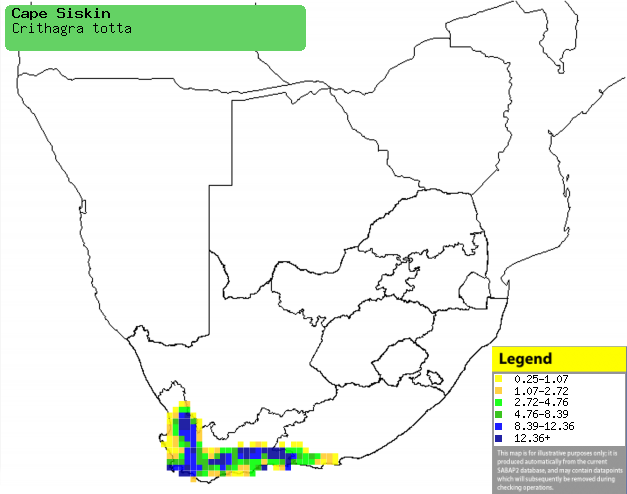|
Crithagra totta (Cape
siskin)
[= Pseudochloroptila totta]
Kaapse pietjiekanarie [Afrikaans]; Serin totta [French];
Hottentottengirlitz [German]; Canário do Cabo [Portuguese]
Life
> Eukaryotes >
Opisthokonta
> Metazoa (animals) >
Bilateria >
Deuterostomia > Chordata >
Craniata > Vertebrata (vertebrates) > Gnathostomata (jawed
vertebrates) > Teleostomi (teleost fish) > Osteichthyes (bony fish) > Class:
Sarcopterygii (lobe-finned
fish) > Stegocephalia (terrestrial
vertebrates) > Tetrapoda
(four-legged vertebrates) > Reptiliomorpha > Amniota >
Reptilia (reptiles) >
Romeriida > Diapsida > Archosauromorpha > Archosauria >
Dinosauria
(dinosaurs) > Saurischia > Theropoda (bipedal predatory dinosaurs) >
Coelurosauria > Maniraptora > Aves
(birds) >
Order: Passeriformes > Family: Fringillidae
Distribution and habitat
Endemic to South Africa, specifically occurring in the Cape
Fold Mountains in the Western and Eastern Cape. It generally prefers fynbos on
mountains and in valleys, also occupying clearings in mountain forest patches,
fringes of succulent Karoo, edges of pine plantations and village gardens.
|
 |
|
Distribution of Cape siskin in southern Africa,
based on statistical smoothing of the records from first SA Bird Atlas
Project (©
Animal Demography unit, University of
Cape Town; smoothing by Birgit Erni and Francesca Little). Colours range
from dark blue (most common) through to yellow (least common).
See here for the latest distribution
from the SABAP2. |
Movements and migrations
Resident and partially nomadic, as it may move
to lower altitudes during particularly harsh Winters.
Food
It mainly eats seeds and buds either taken from bare
patches of ground or directly from grasses and shrubs. The following food items have been recorded
in its diet:
- Plants
- seeds
- Ficinia (sedges)
- restios
- Protea
- Athanasia
- Metalasia (blombos)
- Dicerothamnus rhinocerotis (Renosterbos)
- Chenopodium (misbredies)
- Cliffortia
- Erica plukenetti (Hangertjie)
- grasses
- Widdringtonia (cedars)
- Leucadendron (conebushes)
- flowers
- nectar
- Insects
Breeding
- Monogamous solitary nester, building a shallow cup of fine dry grasses and
rootlets or withered Asteraceae flowers and lined with fine grass sometimes
mixed with down, wool or hair. It is typically placed in a horizontal
crevice, small depression or cavity in a rock face or tree, alternatively in
a fern other plant on a rocky ledge.
- Egg-laying season is from August-December.
- It lays 3-4 eggs, which are incubated solely by the female for at least
13 days.
- The chicks are fed by both parents, leaving the nest after about 19
days.
Threats
Although it was previously thought be Near-threatened,
current data suggests otherwise as it is well-represented in protected areas.
References
-
Hockey PAR, Dean WRJ and Ryan PG 2005. Roberts
- Birds of southern Africa, VIIth ed. The Trustees of the John Voelcker
Bird Book Fund, Cape Town.
|
